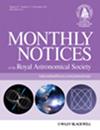Unfruitful chemical pathway for interstellar furan: formation of the four isomers of 1-butenol-3-yne
IF 4.8
3区 物理与天体物理
Q1 ASTRONOMY & ASTROPHYSICS
引用次数: 0
Abstract
Heterocycles have not been detected in the interstellar medium (ISM) yet. However, the direct involvement of some pentagonal heterocycles within the formation of key biomolecules for the origin of life makes the search for these systems in the ISM relevant for understanding whether some of the bricks of life could be formed in the ISM. We have explored the possible formation of the simple heterocycle furan (c-C4H4O) under interstellar conditions, through the reaction between two interstellar species, syn-vinyl alcohol (syn-VA) and the CCH radical. We employed state-of-the-art quantum-chemical calculations to elucidate the reaction mechanism between the reaction of CCH radical and syn-VA. Kinetic simulations were carried out aiming to quantitatively assess the viability of this reaction in the ISM. We have found a reaction pathway to furan where all energy barriers are submerged. However, the formation of this heterocycle is not feasible because the intermediates leading to furan can evolve through more favourable routes. In contrast, we have found viable pathways for the formation of the four isomers of 1-butenol-3-yne (HCCCHCHOH) (Z-syn, E-syn, E-anti and Z-anti), which thus are promising species to be detected in the ISM. Our theoretical work indicates that the four isomers of 1-butenol-3-yne should be present in the ISM, because the precursors are known interstellar species, and the kinetic simulations indicates that their formation is very likely. We then encourage the observational search of these molecules in the ISM.星际呋喃的不成功化学途径:1-丁烯-3-炔的四种异构体的形成
星际介质(ISM)中尚未探测到杂环。然而,由于一些五角杂环直接参与了生命起源的关键生物分子的形成,因此在星际介质中寻找这些系统与了解一些生命之砖是否可能在星际介质中形成息息相关。我们探索了在星际条件下,通过合成乙烯醇(syn-VA)和 CCH 自由基这两种星际物质之间的反应,形成简单杂环呋喃(c-C4H4O)的可能性。我们采用了最先进的量子化学计算方法来阐明 CCH 自由基与 syn-VA 之间的反应机理。我们还进行了动力学模拟,旨在定量评估该反应在 ISM 中的可行性。我们发现了一条通向呋喃的反应途径,在这条途径中,所有能量障碍都被淹没。然而,这种杂环的形成并不可行,因为导致呋喃的中间产物可以通过更有利的途径演化。与此相反,我们发现了形成 1-丁烯醇-3-炔(HCCCHCHOH)的四种异构体(Z-syn、E-syn、E-anti 和 Z-anti)的可行途径,因此这四种异构体有望在 ISM 中被探测到。我们的理论研究表明,1-丁烯醇-3-炔的四种异构体应该存在于 ISM 中,因为它们的前体是已知的星际物质,而且动力学模拟表明它们的形成是非常有可能的。因此,我们鼓励在 ISM 中对这些分子进行观测搜索。
本文章由计算机程序翻译,如有差异,请以英文原文为准。
求助全文
约1分钟内获得全文
求助全文
来源期刊

Monthly Notices of the Royal Astronomical Society
ASTRONOMY & ASTROPHYSICS-
CiteScore
9.10
自引率
37.50%
发文量
3198
审稿时长
3 months
期刊介绍:
Monthly Notices of the Royal Astronomical Society is one of the world''s leading primary research journals in astronomy and astrophysics, as well as one of the longest established. It publishes the results of original research in positional and dynamical astronomy, astrophysics, radio astronomy, cosmology, space research and the design of astronomical instruments.
 求助内容:
求助内容: 应助结果提醒方式:
应助结果提醒方式:


